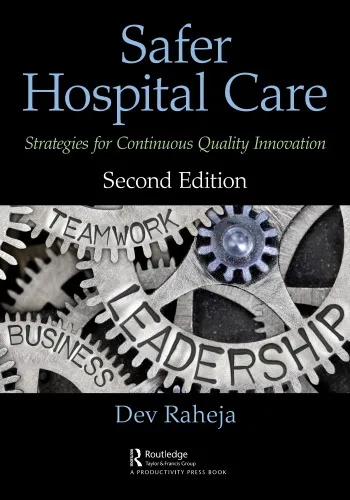Safer hospital care : strategies for continuous improvement
4.4
Reviews from our users

You Can Ask your questions from this book's AI after Login
Each download or ask from book AI costs 2 points. To earn more free points, please visit the Points Guide Page and complete some valuable actions.Introduction to "Safer Hospital Care: Strategies for Continuous Improvement"
Hospitals are meant to be sanctuaries of healing, yet errors in hospital settings can sometimes lead to harm that far exceeds the illnesses patients came to address. "Safer Hospital Care: Strategies for Continuous Improvement" is a groundbreaking work that tackles this very dilemma, offering a comprehensive guide to improving the safety and quality of care provided across healthcare systems. This book provides a clear roadmap for hospital administrators, clinicians, and healthcare professionals to foster a culture of safety, reduce systemic risks, and implement practical strategies for continuous improvement.
Authored by Dev Raheja, this book integrates the latest advancements in patient safety, systems thinking, and risk mitigation to create an indispensable resource for anyone committed to making healthcare environments safer. With a focus on actionable implementation strategies rather than just theoretical discussions, this book is both practical and enlightening, illuminating the path toward achieving error-free hospital care. Readers will find concepts deeply rooted in real-world case studies, research, and evidence-based practices.
Detailed Summary of the Book
"Safer Hospital Care" is centered on actionable strategies to identify and eliminate systemic risks within hospitals, ultimately reducing adverse events. The book begins by analyzing the foundational reasons why hospital errors occur, encompassing human factors, process inefficiencies, and communication failures. Dev Raheja emphasizes that most errors stem not from individual negligence but from system limitations and process gaps. This perspective makes it easier for healthcare leaders to tackle problems at their root causes.
The first sections of the book provide the reader with an in-depth understanding of hospital systems through the lens of engineering, psychology, and organizational management. Raheja introduces the critical role that system-based thinking plays in improving safety. From there, the chapters dive into practical methods for conducting risk assessments, designing error-resistant processes, and implementing robust quality systems.
Central to the book's philosophy is building a culture of safety, where every team member—from top executives to frontline staff—is empowered and expected to prioritize patient well-being. With tools like Failure Modes and Effects Analysis (FMEA) and incident root cause analysis, Raheja bridges the gap between theoretical knowledge and on-the-ground application.
Devoting attention to leadership and teamwork, the book explores how interprofessional collaboration can make even the most complex hospital systems function smoothly. Additionally, it presents a host of examples from successful safety practices worldwide, demonstrating that hospitals of all sizes can adopt these models to drive change.
Key Takeaways
- Understanding the root causes of hospital errors and system failures is essential to creating safer patient care practices.
- A strong culture of safety can make significant strides in reducing medical errors and improving outcomes.
- Effective tools, such as Failure Modes and Effects Analysis (FMEA), are invaluable in identifying potential risks before incidents occur.
- Leadership, collaboration, and consistent training are the cornerstones of any successful safety improvement initiative.
- Continuous improvement isn’t a one-time fix; it's a dynamic, ongoing process that requires commitment from every level of a healthcare organization.
Famous Quotes from the Book
Here are some powerful quotes from "Safer Hospital Care" that emphasize its core themes:
“In healthcare, progress towards safety is not an option—it’s an ethical imperative.”
“Errors in hospitals are rarely the result of one person; they are often a failure of the system itself.”
“The cost of investing in safety is far outweighed by the cost of not addressing preventable harm.”
Why This Book Matters
"Safer Hospital Care" is more than just a book—it’s a call to action. In an era where patient safety is increasingly scrutinized, it provides solutions for some of the most pressing challenges in healthcare today. Hospitals operate in high-pressure environments where even minor mistakes can have catastrophic consequences. This book equips healthcare leaders, clinicians, and policymakers with the insights they need to overcome these challenges, leading to safer experiences for both patients and staff.
What makes this book stand out is its ability to break down complex safety challenges into manageable, actionable strategies. It fosters a systematic understanding of how interconnected processes work—and how they can be enhanced for optimal safety and efficiency. The value of this book lies in how universally applicable its principles are, whether you run a small community hospital or a vast urban medical center.
"Safer Hospital Care" underscores the importance of building a proactive, learning-oriented healthcare environment where safety isn’t just a protocol but a deeply ingrained value. Above all, the book illustrates that safer care isn’t a luxury—it’s a standard everyone must strive for.
Free Direct Download
Get Free Access to Download this and other Thousands of Books (Join Now)
For read this book you need PDF Reader Software like Foxit Reader


